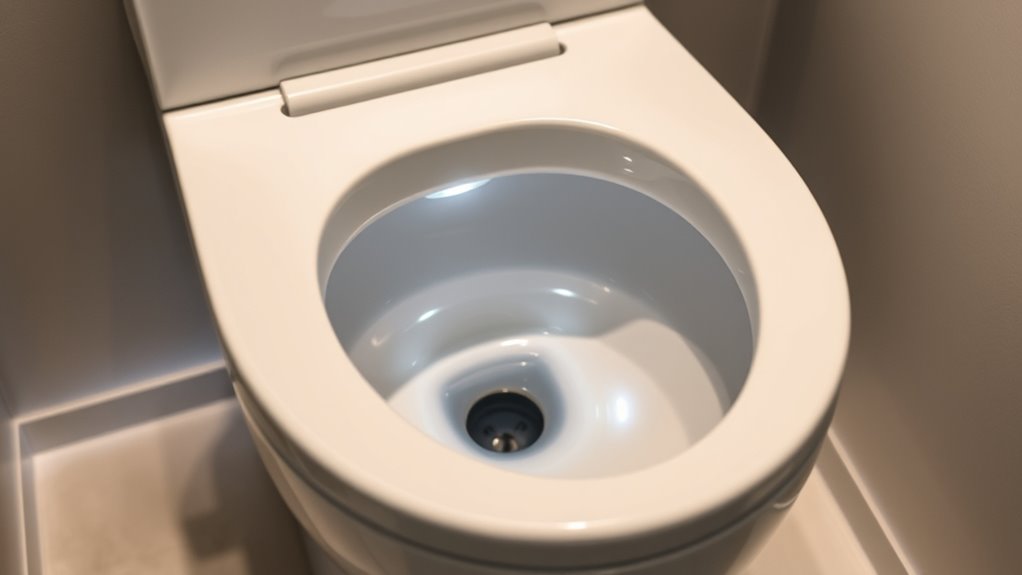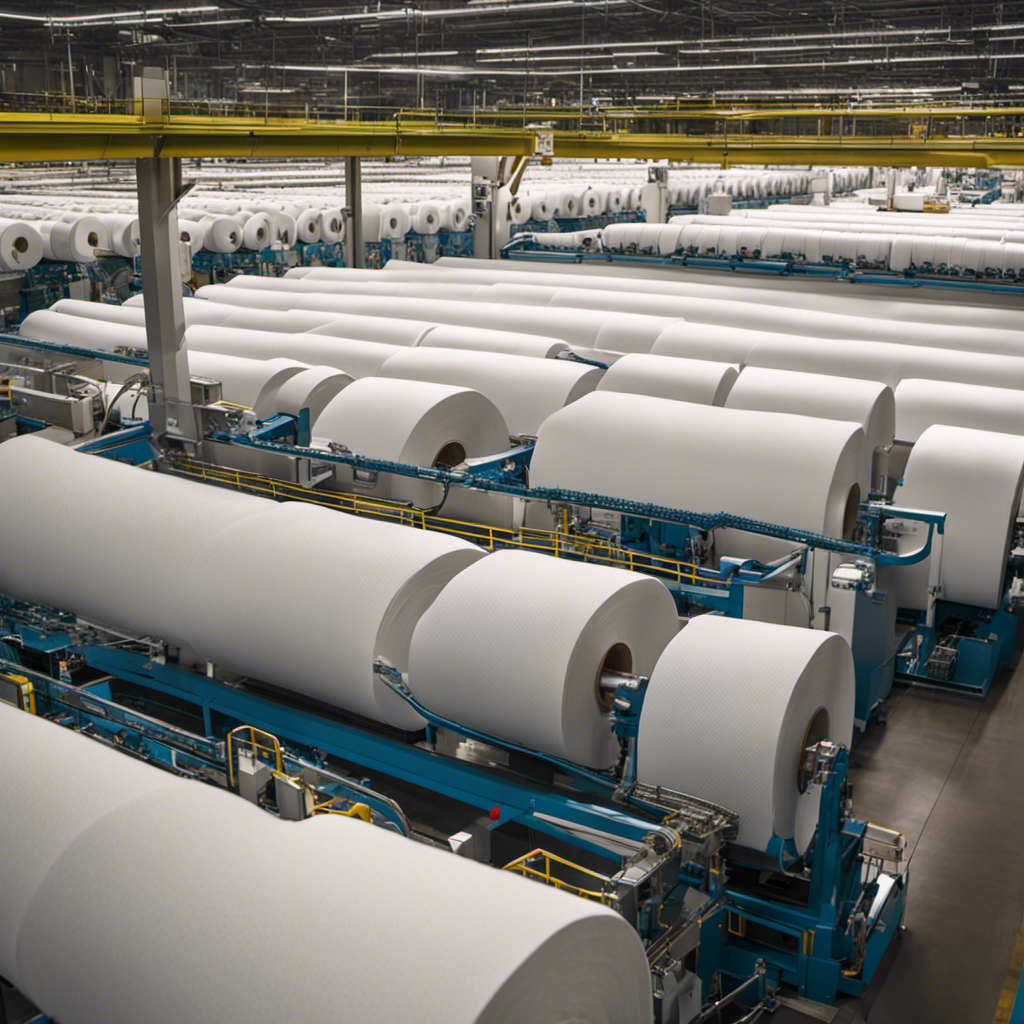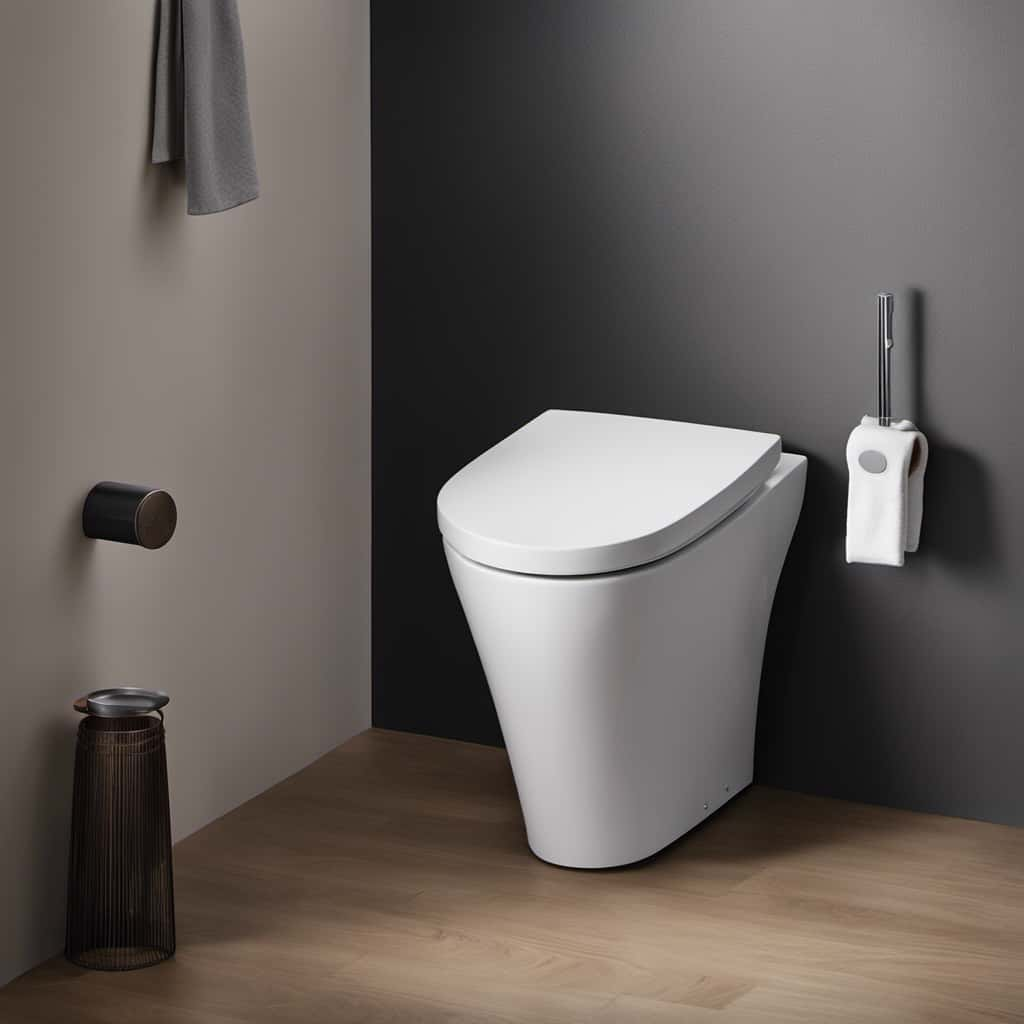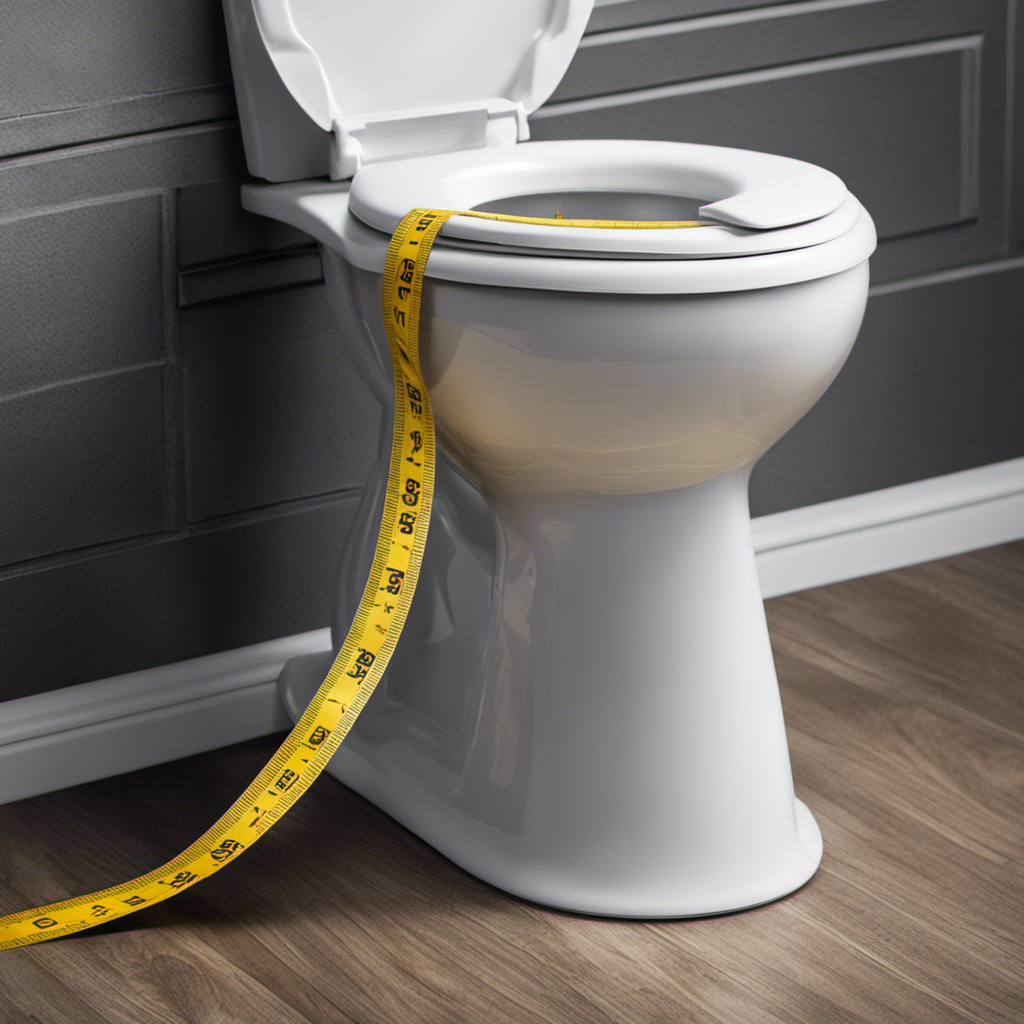A touchless toilet flushes automatically by using sensors, such as infrared or ultrasonic, to detect your presence or absence near the bowl. When you approach or leave, these sensors send signals to activate a small valve that releases water for flushing. The entire process happens seamlessly and without contact, ensuring better hygiene and water conservation. To understand the technology behind these sensors and how they work, keep exploring the details.
Key Takeaways
- Sensors detect user presence or proximity using infrared or ultrasonic technology.
- Detection signals activate the electronic control board and water valve inside the toilet.
- The valve releases water to flush the bowl automatically when triggered.
- Calibration ensures sensors respond accurately, preventing false flushes or missed triggers.
- Power sources like batteries or solar panels supply energy for sensor operation and control systems.
Overview of Touchless Toilet Systems
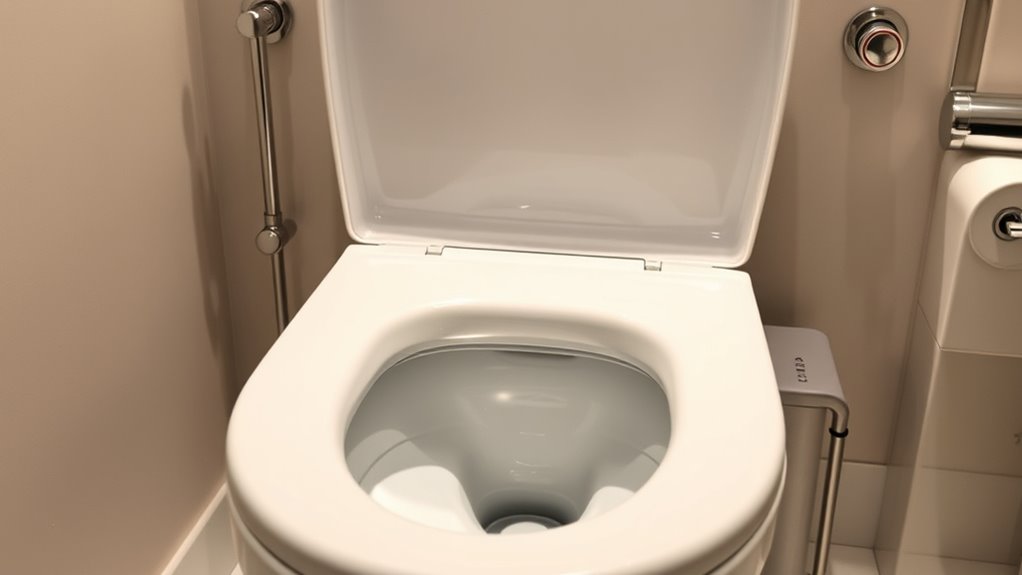
Touchless toilet systems have become increasingly popular because they offer a more hygienic and convenient way to flush. These systems use sensors to detect when you’re finished, activating the flush automatically. One key benefit is water conservation; since the flush only activates when needed, it reduces water waste compared to traditional toilets. Additionally, they enhance user hygiene by eliminating the need to touch flush handles, decreasing the spread of germs. The sensors are typically mounted discreetly above the bowl, ensuring seamless operation. Many models also feature adjustable flushing options, allowing you to choose water-saving modes. Some smart toilets incorporate automatic flushing and sensor-based features that further improve efficiency and hygiene. The sensor technology in these toilets is designed to be highly sensitive, ensuring reliable operation without false triggers. Modern touchless toilet systems often include self-cleaning features that help maintain hygiene and reduce maintenance efforts. These advanced features contribute to hygiene and sustainability, making touchless toilets an increasingly popular choice for modern bathrooms. Overall, touchless toilets provide an efficient, hygienic, and eco-friendly upgrade to standard bathroom fixtures, making daily routines cleaner and more sustainable.
Types of Sensors Used in Touchless Toilets

Touchless toilets typically use sensors to detect your presence and activate the flush. Infrared sensors are common because they sense heat and motion quickly, while ultrasonic sensors use sound waves to detect nearby objects. Understanding these sensor types helps you see how your toilet responds seamlessly to your movements. Additionally, divorce statistics highlight the importance of understanding legal options and resources, similar to how recognizing different sensor types can improve your experience with touchless toilets.
Infrared Sensor Technology
Infrared sensor technology is the most common method used to detect when a user is approaching or has left the toilet. It works by emitting infrared light and sensing the reflection from your body. When you move closer, the sensor detects your presence, triggering the flush automatically. This technology promotes water conservation by ensuring the toilet only flushes when needed, reducing unnecessary water use. It also enhances user hygiene by eliminating the need to touch surfaces, minimizing the spread of germs. Infrared sensors are reliable even in low-light conditions and are resistant to dirt or moisture, making them ideal for bathroom environments. Additionally, advances in AI-enabled sensors are further improving the accuracy and responsiveness of touchless toilets. The integration of sensor calibration techniques ensures consistent performance over time, even with environmental changes. Furthermore, innovative sensor designs are helping to minimize false activations and enhance overall reliability. Ongoing research into sensor durability is helping these systems withstand the humid and variable conditions typical of bathroom settings, and the development of smart sensor systems aims to further optimize performance and energy efficiency.
Ultrasonic Sensing Method
Ultrasonic sensing methods provide an alternative to infrared technology for detecting user presence in touchless toilets. These sensors emit high-frequency sound waves, which bounce off nearby objects, including your hand or body, to determine proximity. Proper sensor calibration guarantees accurate detection, minimizing false activations or missed triggers. When installed correctly, ultrasonic sensors integrate seamlessly with the user interface, providing a smooth and responsive experience. They can be adjusted to suit different environments, ensuring reliable operation. Unlike infrared sensors, ultrasonic technology works effectively in various lighting conditions and through obstacles like toilet lids. This makes them a versatile choice for modern touchless toilets, enhancing hygiene and convenience without sacrificing precision or user comfort. Additionally, understanding the contrast ratio of the sensor’s detection range can help optimize performance in different settings. Furthermore, ultrasonic sensors are often less affected by environmental factors, making them more dependable in diverse bathroom conditions. Advances in sensor technology continue to improve the accuracy and reliability of ultrasonic detection systems, further elevating user experience. In addition, sensor calibration plays a crucial role in maintaining optimal performance and ensuring the sensor adapts to specific environmental nuances. Moreover, ongoing research into AI security helps develop smarter sensor systems that can adaptively respond to changing conditions, enhancing overall reliability.
How Motion Sensors Detect User Presence
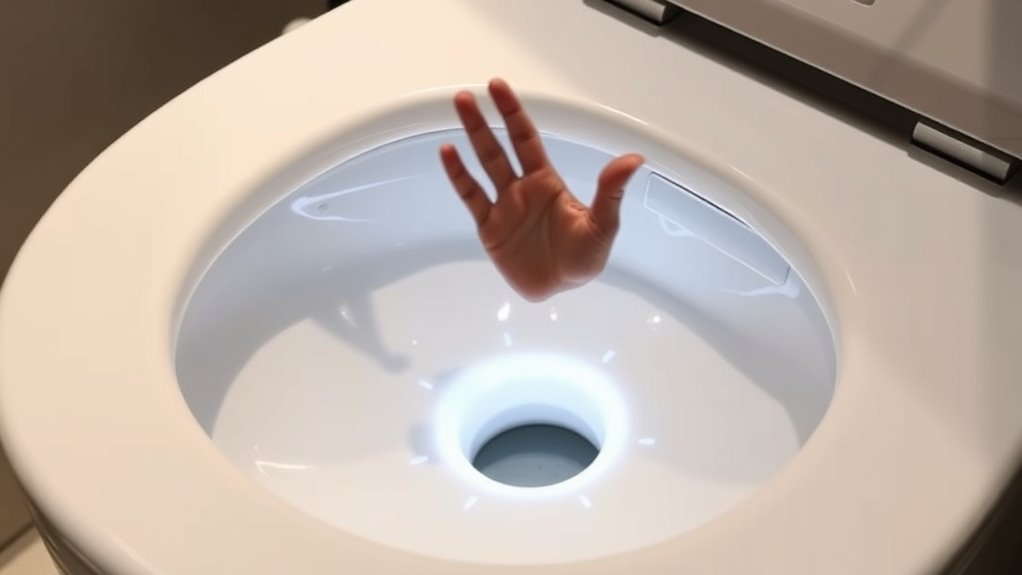
Motion sensors detect user presence by continuously monitoring your environment for movement or changes in proximity. To work effectively, these sensors require proper calibration, guaranteeing they accurately distinguish between genuine user movement and other environmental factors. During calibration, the sensor adapts to the specific surroundings, reducing false triggers and conserving power. Privacy is also a key consideration; sensors are designed to detect only motion, not record images or sounds, safeguarding your privacy. When you approach the toilet, the sensor detects your presence through subtle environmental changes, prompting the flushing mechanism to activate. This seamless detection process makes touchless toilets hygienic and convenient, while careful sensor calibration and privacy measures ensure your comfort and security are maintained at all times. Proper beneficiary designation in related systems can help avoid costly errors and maximize benefits. Additionally, understanding the sensor technology involved can improve the overall effectiveness and longevity of touchless systems. Moreover, advancements in AI-powered sensors continue to enhance sensitivity and reduce false activations, ensuring a more reliable user experience. As technology evolves, the integration of smart sensor systems further optimizes performance and user safety.
The Role of Infrared Sensors in Flushing Mechanisms
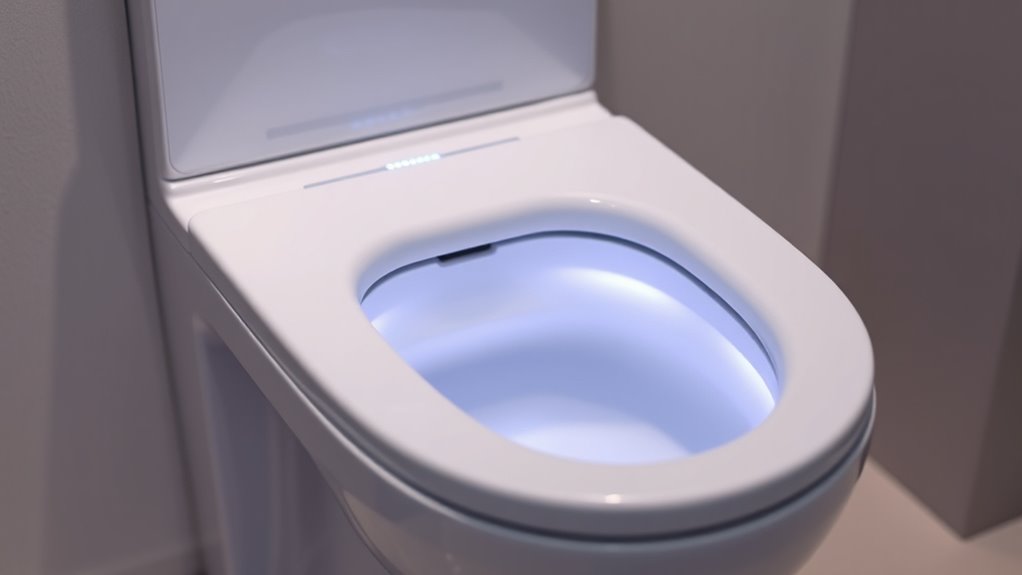
Infrared sensors detect your presence by sensing heat emitted from your body, allowing the toilet to recognize when you’re nearby. This detection triggers the automatic flushing process without any manual effort. Understanding how these sensors work helps you appreciate the seamless experience of touchless flushing.
Infrared Sensor Detection
How do touchless toilets know when to flush? Infrared sensors detect your presence by emitting and sensing infrared light. When you move away, the sensor registers the change and triggers the flush. Proper sensor calibration guarantees accurate detection, preventing false triggers or missed signals. The user interface allows you to adjust sensitivity, optimizing performance. Infrared sensors work silently and efficiently, making hygiene easier. Here’s a quick visual:
| Action | Sensor Role | Result |
|---|---|---|
| Detects user proximity | Emits infrared light, measures reflection | Initiates flush |
| User moves away | Detects change in reflection | Completes flush |
| Calibration adjustment | Fine-tunes sensitivity | Accurate detection |
| User interface input | Sets sensitivity levels | Improved performance |
| No motion detected | Infrared signal absent | No flushing triggered |
This system ensures reliable, contactless operation. Additionally, sensor maintenance is essential to keep the system functioning optimally over time. Regular cleaning and calibration help maintain sensor accuracy, ensuring the flush mechanism responds correctly. Proper maintenance not only extends the lifespan of the components but also enhances overall system reliability.
Automatic Flushing Process
Once the sensor detects that you’ve moved away, it sends a signal to activate the flushing mechanism. This automatic process guarantees the toilet flushes at the right moment, promoting water conservation by preventing unnecessary flushing. Infrared sensors detect your presence and absence, allowing the toilet to operate efficiently without manual contact. This not only conserves water but also enhances user hygiene by reducing contact with surfaces that might harbor germs. The sensor’s quick response ensures a smooth, seamless flush, making your experience more hygienic and eco-friendly. You don’t need to press a button or handle, which minimizes the spread of bacteria. Overall, the infrared sensor’s role in the automatic flushing process combines water efficiency with improved hygiene, making touchless toilets a smart choice for modern bathrooms.
The Process of Triggering a Flush Automatically
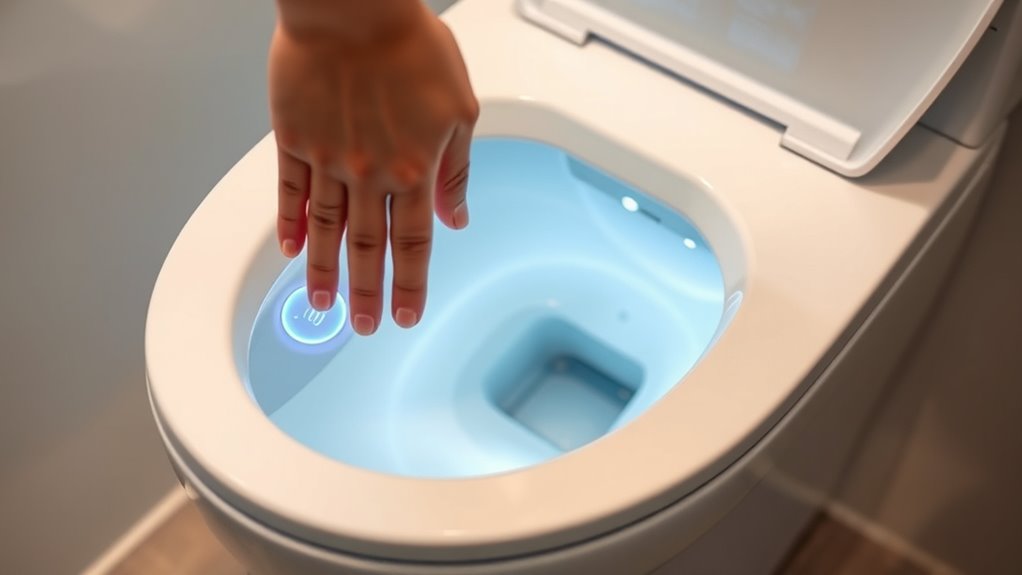
When you step away from the toilet, sensors detect your presence or absence and automatically trigger the flush. This process guarantees water is used only when needed, promoting water conservation. The sensors are usually infrared or ultrasonic, which detect movement or heat changes around the toilet. Once your presence is gone, the sensor sends a signal to activate the flushing mechanism. This automatic action minimizes contact with surfaces, enhancing hygiene benefits by reducing the spread of germs. You don’t need to press a button or handle, making the process seamless and hygienic. The system is designed to be quick and efficient, ensuring the toilet is ready for the next user while conserving water and maintaining cleanliness effortlessly.
Components Inside a Touchless Toilet System
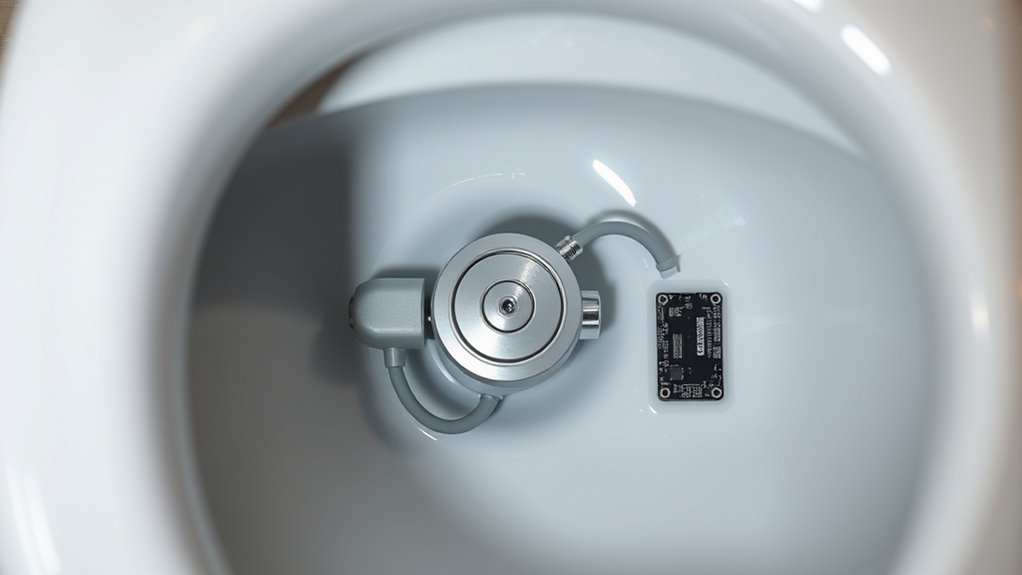
A touchless toilet system relies on several key components working together to guarantee seamless operation. At its core is the sensor, which detects your presence and triggers the flush automatically, promoting better user hygiene by reducing contact. The valve mechanism controls water flow, designed to conserve water with precise, efficient flushing cycles, supporting water conservation efforts. The electronic control board processes signals from the sensor and activates the valve accordingly. A small, built-in reservoir or supply line provides a steady water source. These components work in harmony to deliver a hygienic, water-efficient experience. By integrating sensor technology and efficient water control, a touchless toilet minimizes germs and waste, making your bathroom both cleaner and more eco-friendly.
Power Sources and Energy Efficiency
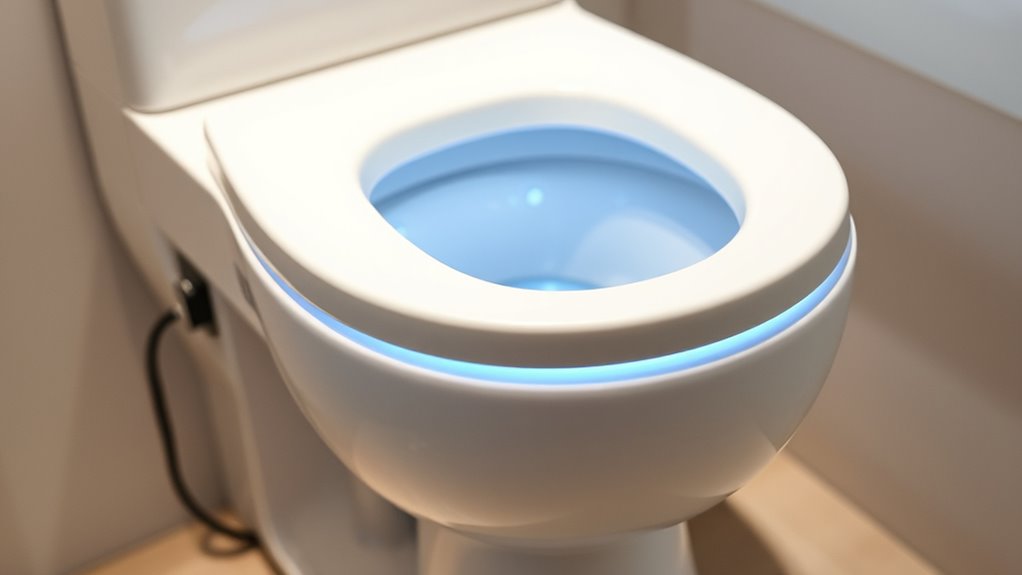
How do touchless toilets stay powered without wasting energy? They typically use low power consumption sensors and energy-efficient components to maximize energy savings. Many models rely on batteries or energy harvesting techniques, such as solar panels or kinetic energy, reducing the need for constant electrical power. This approach ensures minimal energy use while maintaining reliable operation. To illustrate, here’s a comparison:
| Power Source | Energy Efficiency |
|---|---|
| Batteries | Require replacement but optimized for low power use |
| Solar panels | Harness free, renewable energy, enhancing energy savings |
| Kinetic energy | Convert motion into power, reducing waste |
| AC power | Consistent supply but higher energy consumption |
| Hybrid systems | Combine sources for ideal efficiency |
Understanding these options helps you appreciate how touchless toilets balance power consumption with energy savings.
Advantages of Using Touchless Technology in Bathrooms
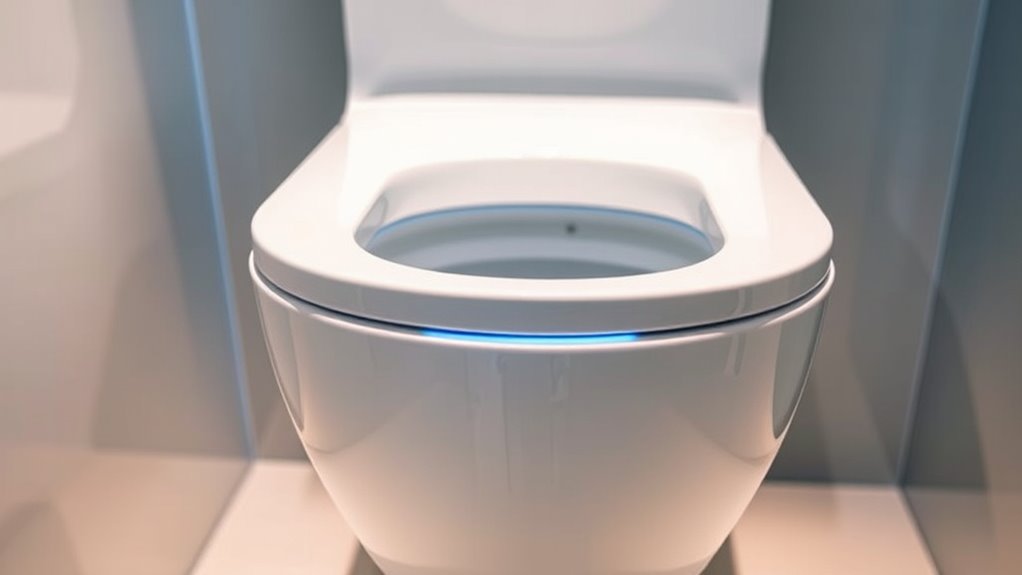
Touchless technology offers significant advantages in bathroom safety and hygiene by eliminating the need to touch surfaces. When you use a smart bathroom, you reduce the spread of germs and bacteria, keeping everyone healthier. This technology also enhances convenience, allowing you to operate fixtures without fumbling for handles or buttons. It’s especially helpful in public or shared spaces, where maintaining cleanliness is vital. Additionally, touchless systems often conserve water, making them environmentally friendly and cost-effective over time. The seamless operation of touchless technology creates a more modern, efficient bathroom experience. By adopting these innovations, you not only improve hygiene but also enjoy a cleaner, safer environment, making everyday routines simpler and more hygienic.
Common Challenges and Maintenance Tips
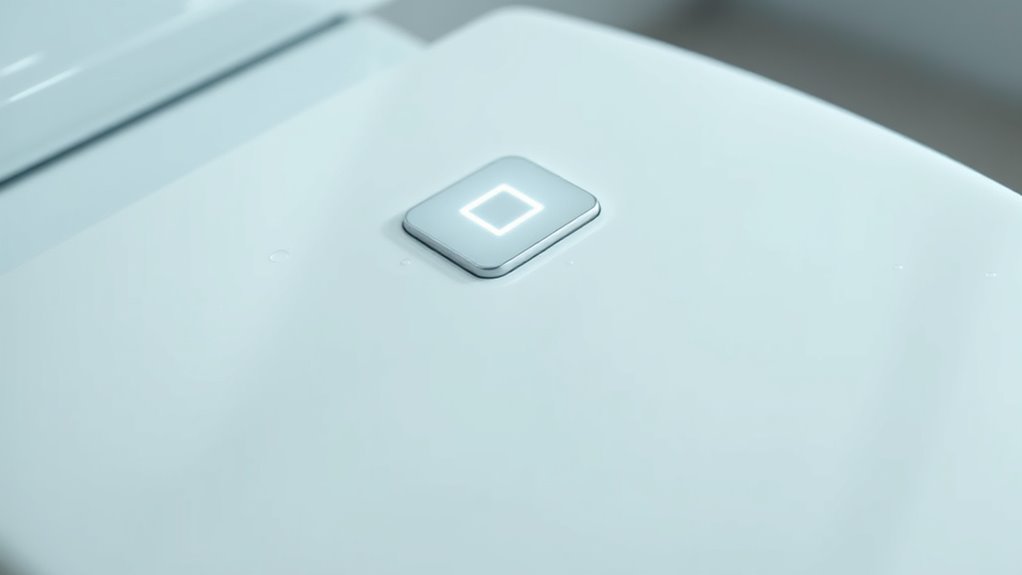
While touchless toilet systems offer many benefits, they can also present some common challenges that users should be aware of. One issue is the user interface, which may sometimes be unresponsive due to dirt or sensor misalignment. Regular cleaning of sensors helps guarantee smooth operation. Additionally, sensors can mistake other objects or motion for commands, leading to accidental flushes or failures. Another challenge involves water conservation; some systems may not optimize water use, wasting more than necessary. To prevent this, check and adjust the settings as needed. Routine maintenance includes cleaning sensors, inspecting wiring, and replacing batteries or faulty parts promptly. Staying attentive to these issues helps keep your touchless toilet functioning efficiently and preserves water resources.
Frequently Asked Questions
How Do Touchless Toilets Prevent Accidental Flushing?
You might wonder how touchless toilets avoid accidental flushing. They do this through precise sensor calibration and user detection. When you approach, sensors detect your presence and activate the flush only when you intentionally leave the seat or move away. This careful calibration prevents false triggers, ensuring the toilet flushes only when needed, making it both convenient and hygienic without risking accidental activations.
Can Touchless Toilet Sensors Be Adjusted for Sensitivity?
You can usually adjust the sensor calibration to change the sensitivity of your touchless toilet. Most models have a control panel or settings menu that lets you fine-tune sensitivity adjustment, ensuring the sensor responds accurately without false triggers. Refer to your toilet’s user manual for specific instructions, but generally, you’ll find a way to set the sensor’s responsiveness to suit your preferences and bathroom environment.
What Happens if the Sensor Fails to Detect User Presence?
If the sensor malfunctions and fails to detect your presence, the toilet won’t flush automatically. You might notice false triggers, where it flushes unexpectedly or not at all. In such cases, it’s important to check for sensor dirt, misalignment, or power issues. Regular maintenance can prevent sensor malfunctions, ensuring smooth operation. If problems persist, replacing or repairing the sensor is usually necessary to restore proper automatic flushing.
Are Touchless Toilets Compatible With Existing Plumbing?
Imagine a seamless dance between your bathroom and technology—touchless toilets are designed for easy installation compatibility with most existing plumbing requirements. You’ll find they adapt smoothly, like a puzzle piece fitting perfectly. While some models may need minor adjustments, generally, they integrate effortlessly without major plumbing overhauls. So, you can upgrade your bathroom with minimal fuss, enjoying hands-free convenience without worrying about complex plumbing changes.
How Long Do Batteries Typically Last in Wireless Touchless Toilets?
You might wonder about the battery lifespan in wireless touchless toilets. Typically, batteries last between 6 months to 2 years, depending on usage and power management features. Proper power management conserves energy, extending battery life. Regularly check the indicator lights or notifications to guarantee timely replacements. Using energy-efficient sensors and limiting unnecessary flushes can also help maximize battery lifespan, so your toilet stays functional without frequent battery changes.
Conclusion
Embracing touchless toilets gently guides you toward a more hygienic and seamless bathroom experience. By choosing this thoughtful innovation, you contribute to a cleaner, more comfortable environment for everyone. It’s a quiet step toward modern comfort, where technology cares for your needs without fuss. As you enjoy the subtle ease of touchless flushing, you help create a space that feels safe, fresh, and welcoming—making everyday moments a little more effortless and a lot more considerate.
